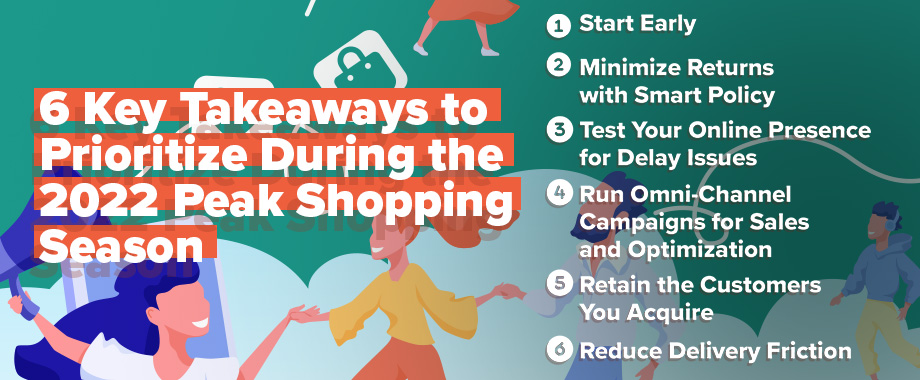6 Key Takeaways to Prioritize During the 2022 Peak Shopping Season

The holiday season is all about giving. But from the retailer’s perspective, you have to give a lot. You have to give customers a smooth delivery experience. You have to give them a product they don’t want to return. You have to give them incentives to shop with you, rather than your competitors.
What are consumers looking for you to give them during peak shopping season, and how can you prioritize those expectations to build a successful holiday campaign? Let’s dive in.
Takeaway #1: Start Early
Inflation is a concern on everybody’s mind. This summer, research showed inflation has risen to Concern #1 for most Americans. Inflation can have unexpected effects on consumer spending habits, and it doesn’t always mean they’ll be saving instead of spending.
If anything, the numbers suggest they’ll want to shop early—before prices go up. According to McKinsey, 52% of shoppers in 2022 say they’re willing to shop early due to concerns about prices going up. But that’s not the only element at play. 51% of customers are concerned about supply issues or product availability during peak shopping season. Other typical holiday concerns, like shipping (42%) or shopping early to spread out the purchases (39%) took a backseat to economic issues.
Getting ahead of these concerns should be your top priority. Think about the 52% of shoppers buying early because of inflation. What’s their primary concern? Price. Pricing discounts early on can not only draw in more customers—it may specifically target those price-conscious customers who are trying to get an early start on the season.
There’s one additional advantage to starting early: getting a better handle on your inventory needs. Companies like Walmart, Target, and Kohl’s have seen all sorts of struggles due to overestimating inventory ahead of the holiday season. Get a start on your holiday discounts. You’ll get a better sense of what kind of customer demand you can expect throughout the season.
Takeaway #2: Minimize Returns with Smart Policy
None of your preparations will matter if too many customers return their purchases. And according to Digital Commerce 360, some companies say return rates as high as 70% between Christmas and New Year’s in 2021. Here’s how to avoid high return rates:
- Add post-purchase content. Helpful tips for getting the most out of a product, for example, reinforce its value proposition. A survey by Nostro found 61% of retail customers believed this would reduce the chance of asking for a return.
- Charge for returns. Although every brand wants a reputation for being helpful and always accepting returns, it’s not always realistic. Zara made waves with a small charge for every return—deducted from the value of the order—but the fashion company has said it hasn’t affected sales.
Every company can expect returns during peak shopping season. The key here isn’t to ignore them, but to minimize them. Even if you don’t charge for returns, remember to add to your post-purchase content to encourage more customers to give your products a chance.

Takeaway #3: Test Your Online Presence for Delay Issues
One second. That’s all it takes for some customers to determine that they don’t want to buy that Christmas sweater from you, but from a competitor.
For that reason, Abercrombie & Fitch has been pre-testing its holiday readiness every year since 2010. That’s been a key element in their digital growth. Digital sales accounted for $1.7 billion in Abercrombie’s sales, or over half of its total sales.
Holidays are crunch time for retailers, after all. According to Tricentis, about 20-30% of a retailer’s sales come through the holiday season. And given that a customer’s average buy at A & F might require 82 separate technological pathways, according to Tricentis, any one kink in the hose can cost a sale. Even worse, it might cost a lifelong customer.
That’s why Abercrombie & Fitch tests its capabilities for handling traffic loads well before those peak holiday hours. That means simulating tens of thousands of orders per hour for the brand. The approach has been so successful, Abercrombie & Fitch rolled out its tests to last throughout the year. The continual testing hasn’t only kept them digitally in tune for the holiday season, but it’s kept orders flowing throughout the year.
Takeaway #4: Run Omni-Channel Campaigns for Sales and Optimization
Customers live in a omni-channel world. They’re going to see multichannel ads. And if they don’t see them from you, they’ll see them from your competitors. In the heightened advertising atmosphere of the holiday season, it only makes sense to run your own multichannel campaigns.
Even holiday-friendly retailers like Harry & David (fruit gifts + confectionaries) find success in embracing the multichannel approach. Their solution was to work with RetailMeNot in a few different ways: homepage carousels, email newsletters, mobile push notifications, and more. These went along with their typical in-store holiday offerings.
Harry & David could have been content with its in-store customers. After all, Harry & David is a favorite with people who like to shop in-person. But they kept multiple channels open and discovered that people liked shopping on their phones as well.
With their multichannel campaign, mobile clicks went up 9.8x year-over-year. Online clicks increased by 21%. Not only did this drive holiday sales, but it introduced other possibilities for future campaigns based on which channels performed the best. The conclusion? Multichannel campaigns aren’t just for this year. They’re also mini-tests for future years.
Takeaway #5: Retain the Customers You Acquire
Peak shopping season should be about more than maximizing sales in the present. It should be about capturing customers’ long-term loyalty while their wallets are out, potentially setting up your brand to make sales throughout the year. But it’s not enough to collect an email address, add customers to a list, and hope for the best. You need to build programs that optimize customer loyalty:
- Synchronize your customer retention strategies to your target demographics. For example, millennials are the largest-spending group (27% higher budget than demographic age group averages). Six out of 10 millennials belong to a customer loyalty program, and even more maintain a retailer credit card. Meanwhile, getting a follow on social media is an appropriate way to stay in front of Gen Z shoppers, with 60% using social media to follow up on their favorite brands’ values.
- Customer segmentation. Segment your email list based on purchase history. First-time holiday purchasers may need more finesse than your already-established customers. To create “psychographic” segments—segmenting customers on tastes and buying history—send out automated surveys after the holidays. Watch what customer buying habits tell you about their preferences. Then leverage those preferences to create new campaigns in future holiday seasons.
Takeaway #6: Reduce Delivery Friction
The holidays are typically when customers are most anxious about delivery friction. They have to have those gifts, and there’s no putting off Christmas. McKinsey’s omnichannel delivery analysis revealed some specific ways retailers can reduce friction and build a more pleasant customer experience:
- Ease of returns. Expect an average rate of 20-30%, or almost one-third of all sales. This is an opportunity to build a relationship with customers. An easy return experience can make them more likely to seek you out when they think of the next gifts to buy.
- Communicate clearly on deliveries. If you can’t out-race Amazon, your clarity can still drive a great customer experience. “Clear communication, predictability, and narrow delivery windows are essential to get [delivery] right,” says McKinsey
The Holiday Season: A Gift that Keeps on Giving
Done right, a successful holiday campaign doesn’t just optimize holiday sales. It should optimize customer loyalty for the entire year, allowing brands to build campaigns that last well into the new year. Put your priorities in the right place, and you won’t just have a successful season. You’ll build brand loyalty that keeps on giving throughout the year. Only this time, it will give back to you.
About the author: Ashley R. Cummings is a professional freelance writer and content marketing consultant specializing in e-commerce, marketing, and SaaS. Connect with her on Twitter!




